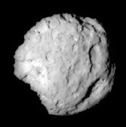Cometary encounter
Planetary scientists are feasting on close-up images of Comet Wild 2 (pronounced “vilt-two”). When the Stardust spacecraft flew within 236 kilometers of the frozen body on Jan. 6, NASA released five images showing craters, spires, mesas, and jets of gas and dust peppering the comet’s craggy surface (SN: 1/10/04, p. 19: Taste of a Comet: Spacecraft samples and views Wild 2). Now, researchers have unveiled additional images as well as the first compositional information from the cometary encounter.

“We were totally stunned,” says Stardust scientist Donald E. Brownlee of the University of Washington in Seattle. “We expected to see a subdued old surface like someone had dumped powdered charcoal on a body.”
The 100-meter-high spires and other features suggest that the comet isn’t a loose agglomeration of smaller pieces, but is a single porous mass, similar to freeze-dried ice cream, says Brownlee. His team and others report their findings in four articles in the June 18 Science.
A Stardust detector found that the comet has an abundance of organic materials, in keeping with the possibility that such icy bodies delivered to the early Earth chemicals that served as prerequisites for life. The craft detected nitrogen-carbon bonds that are essential to DNA.
The mission also collected samples. “The astrobiologists are very much looking forward to getting [this] material back to the laboratory a year and a half from now,” says Brownlee.







